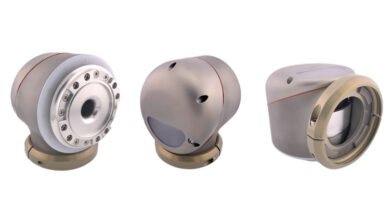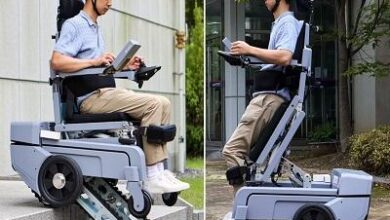Muscle-Based Actuators Could Maximize Potential of Robotic Solutions

A group of innovative engineers from MIT just created muscle-based actuators that could revolutionize robotics. The creative minds behind the project combined a specially designed mono-directional actuator with lab-grown muscle cells to enable lightweight performance. Here’s how this new type of muscle-based actuator could help power robots shortly.
Bio Flexures Muscle-Based Actuators
A paper recently published in the journal Advanced Intelligent Systems explains how a new type of bio flexure could provide repeatable and reliable results that are many times more efficient than a previous attempt. To accomplish this task, the team needed to reinvent the concept of a flexure.
They used a thinner flexure design that acts like a skeleton. The flexure features a pin that is connected to the base layer on each corner. There are several rectangles within each other that were specifically designed to create exact tension in the muscles when needed.
The engineers then bound muscle bands specifically to provide accurate contractions. This approach enabled researchers to run a series of tests that hadn’t been previously done. The results were eye opening.
-
Muscle-basis Actuator
Testing
The research team details how they created a new method of muscle contractile dynamic tuning to enhance the performance of their biohybrid actuator. The testing began with measuring the distance between the posts. From here, the flexure was stretched and responded five times.
This frequency-independent testing enabled researchers to determine when muscle fatigue had affected performance accurately. This tuning enabled them to get maximum endurance out of their creations. It also revealed that higher intervals burnt out the muscle fibers faster.
Skeletal Muscle Tissues
Researchers have looked at a lot of different muscle types before deciding on their final option. Mice muscular tissue was chosen due to its availability, affordability, and that it can easily be grown in a lab. The resulting muscle fiber provided the results desired by researchers.
Biohybrid Robots
The idea of robots that use organic material might seem right out of a sci-fi thriller. However, biohybrid robots have already existed for over a decade. These machines combine natural aspects, such as muscle fibers, with robot functions to create impressive results.
Already, some robots use muscle-based actuators to duplicate complex human tasks such as swimming or dancing. These “soft robots” leverage an artificial skeleton for structure and stability. This approach enables engineers to create more articulate and precise movements that can match the delicateness of a human hand.
Muscle Fibers vs Synthetic Actuators
Muscle fibers are great at converting mechanical and electrical energy into controllable actions. As such, it makes sense that robotics engineers seek to duplicate these benefits. Compared to traditional actuators, biohybrid actuators enable ultraprecise movement. They offer a combination of strength, efficiency, and adaptability that continues to make them a topic of discussion.
Additionally, These devices use less energy to operate, offer more trackability in terms of measuring capabilities, and can be made much smaller. The main factors determining an actuator’s quality are its ability to provide reliable results, durability, accuracy, and force capability.
Types of Biohybrid Robots
There are many different types of biohybrid robots in use today. These devices are as diverse as the world around you. However, the three main categories are microorganisms, tissue, and skeletal.
- Microorganic robots could one day help you heal or conduct health scans of the air you breathe. These devices are built into or leverage components of cells to accomplish tasks. They are incredibly tiny, which makes them ideal for tasks requiring exceptional precision.
- Tissue-based bots leverage muscle fibers and other tissue grown in the lab. These devices could one day help blind people see or amputees walk. Combining tissue with robotics lowers costs for small repetitive tasks and offers engineers the ability to build self-healing machines.
- Skeletal-based robots use a bio-based skeletal structure that makes them ideal at duplicating certain natural movements. Walking, jumping, and dancing are all examples of natural movements that skeletal-based robots could one day master.
Actuators
Biotech brings a lot of advantages to robotics. One area in particular that has seen a lot of interest is biohybrid actuators. An actuator is a device that can convert some form of energy into a controllable response. They are found in most robotics in some form and improving on these devices has an immediate effect. There are actuators that convert heat, pressure, electricity, and magnetic energy.
Flexures
One form of actuator that is ideal for use in biohybrid robots is flexures. Flexures are compliant mechanical elements. These spring-like devices leverage a flat zigzag structure that can be adjusted to provide micro-accurate movements. These actuators are small and lightweight which makes them ideal for robotics.
Adjustability
The engineers noted the force of the flexure can be altered depending on the material, method, and how thin or far apart the beams that connect to the bases sit from each other. The layout was designed to optimize the muscle’s natural movement and combine it with flexure’s stiffness and degree of movement.
These new Flexors are crucial due to their accuracy. They can flex and stretch with nanometer precision, making them ideal for microrobotics. Additionally, the increased stroke output provides higher performance
Challenges Faced
One of the main issues soft robot engineers face is a complete lack of unified design and modeling tools. This lack of standardization has led the industry to fray in all directions, with lots of effort being lost in repeating similar tasks. Plus, the unpredictable nature of biological elements adds another variable that engineers must contend with.
Duplication Problems
Unlike machined parts that can be guaranteed to be the same every time, lab-grown muscle cells can act differently. For example, you know the muscle will contract if stretched, but to get the same result every time without reaching failure is the key.
As such, it’s complicated to create biological components that provide the same performance. Interstingly, advancements in 3d tissue printing could hold the door to solving this issue in the future.
Standards
The success of this venture could help set some universal standards in the biohybrid robotic sector. Currently, there are many different projects, using different setups, to achieve the same goal. The latest innovation was designed to be a universal bio-mechanical actuator.
This approach enables robotic engineers to use these devices whenever needed and cut down on development time. Additionally, these fixtures can combine with other options to support any type of robotic skeletal structure. This model enables engineers to create complex biohybrids that could be tuned to serve specific roles.
MIT Engineers
The team of engineers behind this advantageous effort includes Ritu Raman, Alex d’Arbeloff, Naomi Lynch, Tara Sheehan, Nicolas Castro, Laura Rosado, Brandon Rios, and professor of mechanical engineering Martin Culpepper. Notably, Culpepper is known for his ventures into miniature robotic mechanisms.
It’s this experience that enabled the team to test a variety of actuators before settling on their ultimate decision. They found the accordion-style fixture enabled the muscle tissue to contract naturally while enhancing the spring’s force.
Advantages of Biohybrid Tech
There are a lot of reasons why engineers have sought to combine biology and robotics. This merger could bring endless potential to the market. Imagine robots that get stronger as they do their work can heal and adapt when needed.
Sensory Perception
Biohybrid robots integrate biology at a cellular level, meaning these devices can harness organic material. Nature is full of amazing sensory organs that can detect everything from direction to electrical pulses. Engineers want to tap into these natural sensors to expand robot capabilities.
Brain Interface
Another area of focus for biohybrid engineers is improving how people interact with machines. For example, Elon Musk has spent substantial funding on the neural link interface, which connects to the brain’s neural network and interprets commands directly from thoughts.
Next-Gen Prosthetics
Many people see healthcare as the sector with the most to gain from soft robot integration. Think of a prosthetic made from real muscle tissue, one that the person could work with to improve, and that would replicate the sensations they would associate with the limb.
Sustainability
One of the biggest advantages of biohybrid technology is the ability to create robots that meld perfectly with their environments. These devices could one day monitor the environment and even help repair it. For example, think of sensors that could track and reduce pollution levels.
Future Use Cases
There are many future use cases for this style of muscle-based actuator. These lightweight solutions could be used to power a new generation of micro-robotics. The theory has proven to improve efficiency. As such, from avionics to healthcare there is a lot of attention on the results of this research.
Robots Get Lighter, Smaller, and More Accurate
Reducing power consumption and weight makes sense. You get more life and power out of your devices. Consequently, more engineers seek power-efficient options that can be easily adapted to fit various scenarios. The biohybrid actuator that these engineers created is sure to be the first of many attempts to merge biology and robotics seamlessly to improve lives.
You can learn more about exciting developments in robotics here.



